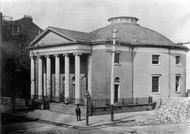Lewis Richards excerpt from Ministers of the PBA
12th Jan 2022
Lewis Richards: b. 1752, Llanbardan Fawr, Cardiganshire, Wales; d. Feb. 1, 1832, Baltimore, Md.; an Anglican Methodist, he studied at Lady Huntingdon’s College at Trevecca, Wales, for a brief period before being sent to America in 1772 to preach to the Indians; settled at Whitefield’s Orphan House, Bethesda, Ga.; adopted Baptist principles and was baptized by Richard Furman at High Hills of Santee, 1777; m. Angelica _________ (1757/8-June 2, 1815, Baltimore, Md.); ord. March 25, 1777, Charleston, S.C.; “He traveled in Georgia and South Carolina for about a year, and then settled in Northampton County, in the Eastern Shore of Virginia, where he remained until 1784, when he came to Baltimore” (Scharf); pastor, First Baptist, Baltimore, Md., 1785-1817, where during his pastorate 293 persons were received into the membership by baptism and 115 by letter. The last three years of his ministry he was assisted by Edmund J. Reis, “a gentleman of French birth,” who succeeded him as pastor. “To show their feelings toward the retiring pastor, it was agreed, Feb. 1818, ‘that the church make ample provision for our late pastor, Bro. Lewis Richards, during the remainder of his life.’ It was decided that $600 per annum should be paid him in quarterly installments, as long as he lived. This was a just tribute to a worthy servant of the Lord, who had ministered to them for a third of a century. A more suitable token could hardly have been given” (Adams & Weishampel). After his resignation in 1817 due to the infirmities of age, Richards remained a member of the congregation until his death. “On the 24th of February, 1818, Mr. Reis was formally elected pastor to succeed the venerable Mr. Lewis, and on the 22nd of March a new church edifice, on the northeast corner of Sharp and Lombard Streets, which the congregation had been engaged in erecting during the past year, was dedicated and occupied. It…was known as the Round Top Church” (Scharf). “In his ministerial labors, till the infirmities of age prevented, [Lewis] was untiring. He not only filled his own pulpit creditably to himself and acceptably to his people, but he traveled much to spread the gospel in regions beyond him. The churches at Taneytown, Fredericktown, Hammond’s Branch and others were indebted to him for sermons. During his ministry of thirty years, the membership [of First Baptist, Baltimore] increased from eleven constituents, to one hundred and sixty-four. His style was decidedly Calvinistic, without the least approach to antinomianism”—George F. Adams.

